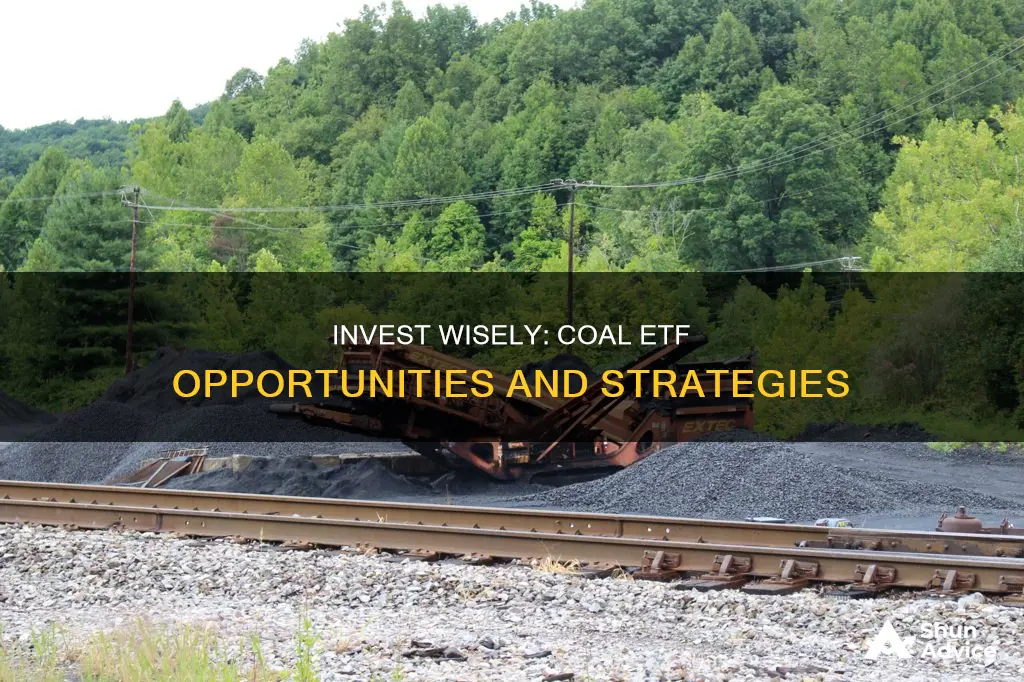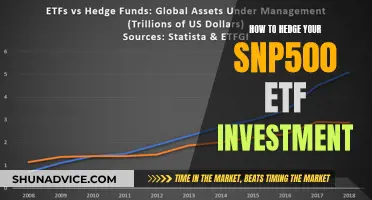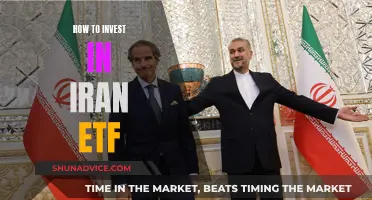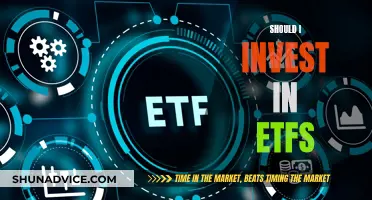
The VanEck Vectors Coal ETF (KOL) was the only coal-focused exchange-traded fund (ETF) but it stopped trading in December 2020. This was due to investors' desire to withdraw from the industry, as well as the incoming Biden administration's emphasis on clean energy. With no coal ETFs currently open in the market, investors interested in this area may want to consider alternative energy ETFs such as the VanEck Vectors Low Carbon Energy ETF (SMOG).
What You'll Learn

Understanding what coal ETFs are
Coal ETFs (exchange-traded funds) are investment funds that focus on companies involved in the coal industry, specifically those that derive a substantial portion of their revenues from coal exploration and production. These companies may include coal miners, coal services providers, and owners of coal reserves.
The structure of a coal ETF allows investors to gain exposure to a basket of coal-related stocks, providing diversification and potentially reducing the risks associated with investing in individual stocks. Coal ETFs can be sector-specific, including companies engaged in mining, processing, and distributing coal and lignite.
Historically, there was the VanEck Vectors Coal ETF (KOL), a coal-focused exchange-traded fund that went public in January 2008. However, as of December 22, 2020, KOL stopped trading and returned investors' money. At its peak in 2011, KOL had $908 million in assets, but the fund's performance declined over the years, with about $35 million in assets at the time of its closure.
As of November 2024, there are no coal ETFs open in the market, indicating a potential shift away from coal as an investment option. However, investors interested in the energy sector can explore alternative energy ETFs, such as the VanEck Vectors Low Carbon Energy ETF (SMOG), which focuses on low-carbon initiatives and has delivered strong returns.
Lithium ETF: A Smart Investment Strategy for Beginners
You may want to see also

Identifying coal companies
As of December 2020, the only coal-focused exchange-traded fund, the VanEck Vectors Coal ETF (KOL), stopped trading. This fund was liquidated due to various factors, including performance, liquidity, and investor interest.
- Company Focus and Operations: Identify companies that have a primary focus on the coal industry, including mining, processing, and distribution. Examples include Alliance Resource Partners LP, Natural Resource Partners LP, and SunCoke Energy Inc.
- Market Presence and Performance: Evaluate the market presence and financial performance of coal companies. Consider their revenue, assets under management, and historical returns. For instance, the VanEck Vectors Coal ETF had $908 million in assets at its height in 2011.
- Business Segments and Diversification: Assess the different business segments and diversification strategies of coal companies. Some companies operate through multiple segments, such as metallurgical, thermal, and idle operations. Diversification can impact a company's resilience and growth potential.
- Environmental and Social Considerations: While investing in coal companies, consider their environmental and social impact. Some companies may have initiatives or commitments to minimise environmental impact, which can influence their reputation and long-term sustainability.
- Industry Trends and Policy Changes: Stay informed about industry trends and policy changes that can affect the coal industry. For example, a shift towards clean energy and ESG (Environmental, Social, and Governance) investing may impact the performance and viability of coal companies.
It is important to conduct thorough research and due diligence before investing in any company or industry. This includes reviewing financial reports, seeking diverse sources of information, and considering both the risks and potential rewards of the investment.
Carbon Credits ETF: A Smart Investment Strategy
You may want to see also

Current market trends
As of November 2024, there are no Coal ETFs open in the market. Coal ETFs invest in stocks of companies that derive a large portion of their revenues from coal exploration and production.
However, there are several coal stocks that investors can consider. The coal sector includes companies that mine, process, and distribute coal and lignite. Some of the top coal stocks include Alliance Resource Partners LP, Natural Resource Partners LP, SunCoke Energy Inc, Warrior Met Coal Inc, and Consol Energy Inc.
It is worth noting that the coal industry has been facing challenges due to the increasing adoption of cheaper and cleaner energy alternatives, such as natural gas and solar power. However, some analysts believe that coal stocks can rally, and global demand for US coal is increasing, making the US a net exporter of coal.
Investing in the Future: 5G ETF Opportunities
You may want to see also

Alternative energy ETFs
While there are currently no Coal ETFs open in the market, alternative energy ETFs are a great way to invest in the energy sector. These funds invest in companies that sell or use solar energy, hydrogen, electric batteries, wind, hydroelectric, and geothermal energies.
VanEck Uranium+Nuclear Energy ETF (NLR)
NLR is a multi-cap fund that focuses on value stocks and has returned 8.3% in the past year. It has an expense ratio of 0.60% and an annual dividend yield of 1.94%. The fund invests in companies involved in uranium mining and nuclear power. Over half of the companies in the fund are based in the US, with other large allocations going to companies in Japan, Canada, and France. Dominion Energy Inc. (D), Duke Energy Corp. (DUK), and Constellation Energy Corp. (CEG) are among its top holdings.
IShares Global Clean Energy ETF (ICLN)
With over $5 billion in assets, ICLN is the largest clean energy fund. It is a multi-cap fund that targets a blend of value and growth stocks, with an expense ratio of 0.42% and an annual dividend yield of 0.67%. ICLN offers broad-based exposure to a variety of sub-industries within alternative energy, with semiconductor equipment stocks making up the largest portion of its portfolio, followed by renewable electricity and electric utilities stocks. Its top holdings include Enphase Energy Inc. (ENPH), SolarEdge Technologies Inc. (SEDG), and Vestas Wind Systems A/S (VWS).
SPDR S&P Kensho Clean Power ETF (CNRG)
CNRG is a multi-cap, blended fund that focuses on alternative energy stocks in developed markets. It has returned -1.5% in the past year, with an expense ratio of 0.45% and an annual dividend yield of 0.74%. Electrical components and equipment stocks make up the largest portion of its portfolio, followed by electric utilities, semiconductors, and renewable electricity stocks. CNRG's top holdings include Enphase Energy, First Solar Inc. (FSLR), and Plug Power Inc. (PLUG).
Invesco Solar ETF (TAN)
TAN has a total expense ratio of 0.67% and primarily invests in solar energy holdings. Its top three holdings as of December 2024 include Enphase Energy, First Solar, and NEXTracker.
IShares Climate Conscious & Transition MSCI USA ETF
This ETF was one of the best-performing clean energy ETFs in 2024.
JPMorgan Carbon Transition U.S. Equity ETF
This ETF was also one of the best-performing clean energy ETFs in 2024.
SPDR MSCI USA Climate Paris Aligned ETF
This ETF was one of the best-performing clean energy ETFs in 2024 and has over $300 million in assets under management.
SSGA SPDR S&P 500 Fossil Fuel Free ETF
This ETF was one of the best-performing clean energy ETFs in 2024.
Warren Buffet's Take on Investing in ETFs
You may want to see also

Historical performance of coal ETFs
As of November 24, 2024, there are no Coal ETFs open in the market. However, here is a historical performance overview of Coal ETFs:
Coal ETFs are a type of exchange-traded fund (ETF) that invests specifically in stocks of companies that derive a significant portion of their revenues from the exploration and production of coal. These companies typically include those involved in mining, processing, and distributing coal and lignite.
The historical performance of Coal ETFs can be analysed through various metrics, including fund flow, returns, assets under management (AUM), expense ratios, and dividend yields. These metrics provide insights into the popularity, profitability, and efficiency of these ETFs.
The fund flow data for Coal ETFs listed on U.S. exchanges offers information on capital inflows and outflows over a particular time period, usually measured in millions of U.S. dollars. This data helps gauge investor interest and the overall popularity of the ETF.
The returns of Coal ETFs can be assessed over different periods, such as the previous day's or month's performance, as well as longer durations like annual or year-to-date returns. Analysing returns helps investors understand the profitability and potential upside of investing in these ETFs.
Assets under management (AUM) is another critical metric, indicating the aggregate value of assets held by a Coal ETF. A higher AUM typically signifies greater investor confidence and a larger pool of capital available for investment.
Expense ratios play a crucial role in evaluating the efficiency of Coal ETFs. This ratio represents the annual fees charged by the ETF as a percentage of the total assets invested. Lower expense ratios are generally favourable as they result in higher net returns for investors.
Dividend yields are also considered in the historical performance evaluation of Coal ETFs. Dividends are distributions of profits paid out to shareholders, usually on a quarterly or annual basis. A higher dividend yield indicates that the ETF has generated substantial profits, allowing for larger payouts to investors.
By examining these historical performance metrics, investors can make informed decisions about investing in Coal ETFs. It is important to note that past performance does not guarantee future results, but it provides a valuable perspective on the risk and return potential of these investments.
A Beginner's Guide to Investing in Vanguard ETFs
You may want to see also
Frequently asked questions
A Coal ETF is an exchange-traded fund that invests in stocks of companies that derive a significant portion of their revenues from the exploration and production of coal.
No, as of November 2024, there are no Coal ETFs open in the market.
The VanEck Vectors Coal ETF (KOL) was the only coal-focused exchange-traded fund, but it stopped trading in December 2020.
The fund stopped trading due to a potential move away from coal with the incoming Joe Biden administration's emphasis on clean energy, as well as investors' desire to withdraw from the industry.
Yes, one alternative is the VanEck Vectors Low Carbon Energy ETF (SMOG), which focuses on low-carbon initiatives and has delivered strong returns.







